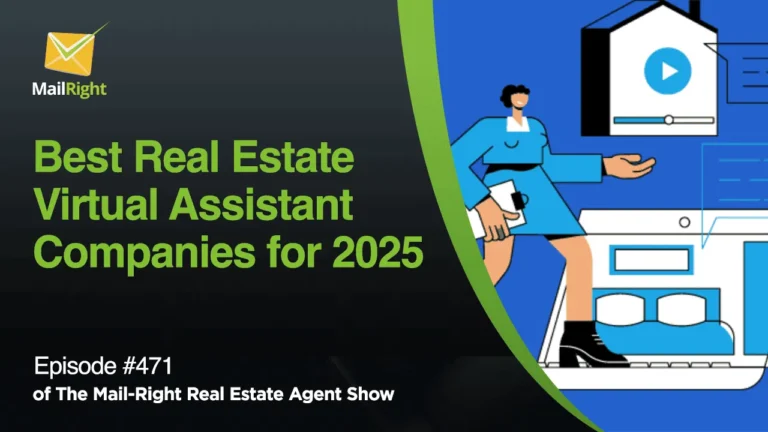On the 419th episode of Mail Right, Robert Newman and Jonathan Denwood discuss a list of YouTube real estate lead generation strategies that will benefit real estate agents in 2024.
Robert Newman, the founder and CEO of Inbound REM, an inbound marketing agency, has over a decade of experience in real estate search engine optimization. Jonathan Denwood co-founded Mail-Right, a lead-generative platform where you can run your Facebook adverts and combine email campaigns, text messages, and a CRM on one platform. This episode uncovers insights, tips, and techniques to generate valuable leads and maximize your online presence.
Creating Videos
When it comes to new real estate agents making more money while spending less and relatively new to the business, the question arises: who’s making millions and how? Well, it usually circles back to using videos, especially on platforms like YouTube. Some agents make money on TikTok and Instagram, but YouTube is the real deal. Using videos for lead generation is highly recommended, especially for new agents. However, videos can also be a game-changer for experienced agents looking to boost their online presence. YouTube videos help generate leads and increase your ranking on Google and your website. They are a big deal for SEO. Once you’ve got a good video on YouTube, you can use it on other platforms. And the traffic you get from YouTube is long-lasting. Unlike Instagram, where your content gets buried under new posts, YouTube videos can keep increasing traffic for years.
Consistency
YouTube wants to see your consistency in producing videos. Consistency will get you marks from YouTube. But unfortunately, because of the nature of the real estate business and its ups and downs, it’s hard to be consistent. On the other hand, you don’t want to use it as an excuse because you have fantastic technology probably in your pocket, your phone, and there are ways of producing video that can work, where you can be flexible to some degree, where you’re taking the video.
If you’re curious how often successful video makers post, they usually do about 100 videos each year, so they post about one every three days. But the most efficient rate seems to be around one per week. However, they could aim for more if they want to be productive. Doing a video daily might not be the best idea unless they focus on shorter videos like reels. Instead, they could try doing three reels and three short videos (each lasting one to five minutes) every week. Occasionally, they could also do a longer video (around 20 or 30 minutes) if they’re confident they can keep their audience interested. When choosing topics, it’s important to pick something engaging. For instance, tools like VidIQ can help with title selection, but focusing on exciting subjects like Google My Business or profile tips and tricks can attract viewers. If you know how to use Google, you just go down and look at people, ask, and decide if you want to create content on any of that.
You must stick to one main topic for your videos to be seen as thought-leaders, like on YouTube. You can’t jump around between different subjects. If you talk about real estate, stick to it; don’t suddenly start making videos about fixing cars. YouTube likes consistency.
Pick A Topic That Is Not Too Broad Or Narrow
It’s crucial to pick a topic that’s not too broad or too narrow. If it’s too broad, YouTube gets confused; if it’s too narrow, you’ll run out of things to discuss. So, finding the right balance is key.
It’s also crucial to check if what people claim is true, especially in real estate, where some may exaggerate their success. By confirming the real transactions, you can learn from others’ success, but don’t copy them exactly. Instead, take inspiration from their style and adjust it to fit your content.
Another tip is to pay attention to comments on popular videos, even from your competitors. People are open about what they like and dislike, which can help you understand your audience better and create content that resonates with them.
Start Making Videos
Don’t get caught up too much about the technology. You’re probably going to have a great phone to take videos. What’s important with videos is the sound quality.
Focus on your Thumbnail
It’s really important to experiment with thumbnails. A great tip is to use Canva for this. If you’re just starting, Canva has many templates that make it easier. You can access these templates for free, but it’s worth paying for the full version, which costs about $120 a year. This will significantly help make your thumbnails look good, especially if you don’t have someone with a good eye for graphics on your team. Spending some time on thumbnails is a worthwhile investment of time and energy.
Thumbnails are important for SEO (Search Engine Optimization). Click-through rates are crucial for both YouTube and regular search engines. The number of times people click on your result directly affects your ranking.
Thumbnails don’t affect overall video engagement much. But whether someone chooses to click on your video or not, thumbnails matter a lot, especially when browsing a list of videos. While the typical talking head thumbnail is compelling, it’s become so common that trying other styles can also make an impression.
It’s good to stick to a branding style for your thumbnails. You can change it yearly, but consistency helps people recognize your content. If you consistently produce high-quality content, people will start recognizing your thumbnails and will click on them because they’re familiar with you and your content. This increases your engagement rate and SEO value. Having a good thumbnail strategy signals to people that it’s your content. Your face also helps with this—people get used to seeing you and will click on your videos because they recognize you.
Improve Your Titles
Choosing the right titles for videos is as important as picking good thumbnails. There are two tool options for this: VidIQ or Tubuddy. While others might prefer VidIQ and Tubuddy, both are useful. Using one of these tools is crucial because it’s like selecting topics for blog posts. Just as writing about something with no audience interest is pointless, making a video with a title that doesn’t attract viewers is a waste, too. It’s also similar to SEO, where picking a highly competitive title for a new channel or website isn’t wise.
VidIQ costs $10 a month and offers excellent value. Another tool worth mentioning is Pinterest. It’s an AI tool that automatically shares website content on different social platforms. Pinterest and VidIQ give the best value for your money. For instance, with just $500 over five years, one can organically grow an audience of 25,000 on Pinterest. VidIQ helps in optimizing titles and descriptions and doing keyword and competitor research. It provides insights on keyword competition, which helps prioritize content.
To improve titles, one can either use these tools, learn from competitor titles, or study marketing language through blogs. Educating oneself to make better titles is essential, even if one doesn’t want to spend $10 on these tools.
Call To Action
People need to do something after watching your videos. You should use the videos to get views, but you should guide people to visit your website. If you aren’t making a blog post with more information about the video, you should lead viewers to a page that offers something valuable to them.
Putting links in the calls to action is also good for SEO. Also, they should include their phone number and a link to a calendar in about half of their videos. A call to action could be a calendar link, and you can expect about five to ten calls a year from videos if you include your number in every video.
Do Property Video Tour
Real estate agents should mix up their videos. But the main thing is to show off properties. Everyone’s interested in houses, so you’ll get viewers if you follow the advice.
There are a few types of posts: ones to get attention, find potential buyers, and build your brand. Property tour videos primarily help with your brand and a bit with getting attention. They’re mainly for people who already know you, not to find new customers unless you’re fortunate. For example, if someone searches for “Camden, Michigan” and finds a video about a property there, they won’t stick around because they’re looking for info about Michigan, not just a house.
Strangely, some property tour videos rank high on YouTube for specific areas with little content. This means there are still places in the US where no one’s doing interesting stuff with videos. So, why do property tour videos? Well, if you have a lot of subscribers or an email list, it’s good for them to see what properties you’re selling. It’s also good for showing potential buyers interesting property features, like a pool or a great view.
If you’re lucky and your video stands out, it might get a lot of views. You can help this by putting special features in the title, like “Amazing Riverfront View,” and the address in the description. Sometimes, a video with an address in the title can get much traffic because people search for addresses online. This can get you more views than big websites like Zillow or Trulia and might even get you some new leads.
Have Testimonials and Case Studies
Case studies and testimonials help you get more leads using videos. Your channel’s first video should be a strong mission statement or an introduction. If you know exactly who you are and what you offer, put that in your intro video. But if you’re unsure, the next best thing is to show what others say about you. Customer testimonials or case studies are great for this. They show what others think about your business. This kind of video can convince people to stick around and watch more of your content.
For example, if the first video they see is a happy customer talking about how great you are, they’re likelier to watch more. Testimonials and case studies can be similar. If you have a smart client or are in the testimonial yourself, you can guide the conversation to highlight key points that make it like a case study.
So, now you’ve got a strong video that’s both a case study and a testimonial. These videos are good at getting people to contact you. They create a real connection with your audience, which is the first step in getting more leads, which is what this series is about.
Create a Strong Bio Video
Bio Video is where you explain who you are. If you make a great video telling your own story and it’s convincing, it can also help get customers. The best thing to do is to have a strong mission and examples of how your product or service helped others. Surprisingly, this combination often brings in customers ready to buy, even for businesses like InboundREM, which charge a lot. Getting such customers means convincing them to spend $20,000 to $50,000 without meeting them in person.
Collaborate With Local Influencers
Becoming the digital leader of your town, area, or city means teaming up with other local businesses to promote. You can highlight restaurants, do reviews, and run joint promotions. It’s helpful, but you must be careful not to confuse people. It depends on what your channel is about. It might not send mixed messages to YouTube if it’s about geography. But if you handle it well, it shouldn’t be a big problem. Being geography-focused can be helpful anyway. Plus, it creates goodwill if you team up with established businesses with a big online presence.
Another idea is to trade with another realtor. It’s called an Agent Takeover Day. It’s an intelligent way for real estate agents, especially those who are into digital stuff, to trade their audiences. This works well if you have a specialty or focus in a particular area and want to reach different types of customers. You give someone access to your audience, and they give you access to theirs. You’re not losing business; you’re just sharing and creating value for both audiences. Good content creators always focus on their audience’s needs, not just what they want to sell. By helping each other out, you can gain more followers and boost your online presence. It’s like getting more people to see your content, which helps with SEO (search engine optimization). So, even if one of your clients likes the other realtor more, the benefits of reaching more people outweigh any potential losses.
Analyze Your Metrics
The great thing about YouTube is it provides fantastic free analytical data. Unlike traditional SEO, where Google intentionally keeps things vague, YouTube provides strong analytical data for free that is easy to access and understand. By watching a few free tutorial videos, one can learn how to interpret and utilize this data to improve their success. Minor changes are significant because they accumulate over time. Many people overlook metrics because it seems like a lot of effort for minor improvements. However, consistently tracking and making adjustments based on metrics can significantly boost effectiveness.
It’s crucial to look at engagement rates, click-through rates, viewer retention, and where viewers drop off. Making small changes based on these metrics, like shortening video length or adjusting content style, can improve performance. Shorter videos rank better globally, while longer ones are better for conversions. A mix of both is often the best strategy.
Occasionally, doing a long-form video is worthwhile because it can build a strong connection with viewers. If you can hold someone’s attention longer, you have a better chance of creating a relationship and gaining a client. Building connections with viewers is the key to success in long-form content.





